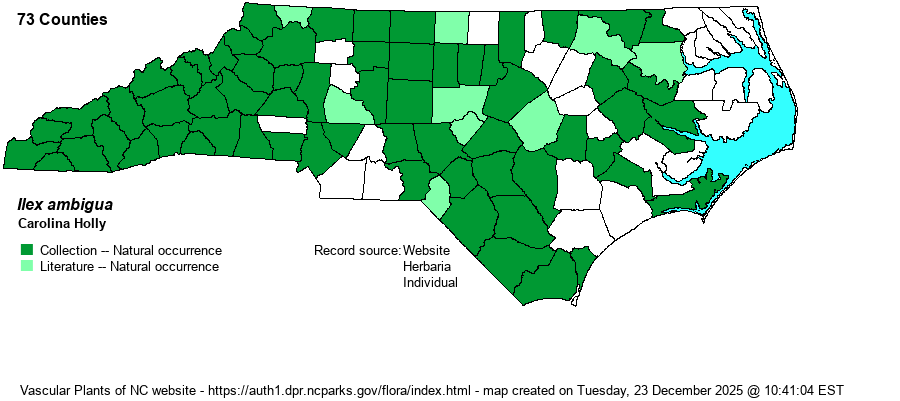| Author | (Michaux) Torrey | |
| Distribution | This species ranges across most of NC, except seems to be absent from the eastern Coastal Plain (i.e., no records yet for north or south of Albemarle and Pamlico sounds). Note that this is a different taxon than the I. ambigua as shown in RAB (1968). Most of the range east of the Mountains as shown on the I. ambigua var. montana map in that reference is actually that for the newly defined I. ambigua. However, things are still unsettled, as what is now being called as this "new" I. ambigua still seems to include at least two different taxa/species -- one with smaller, narrower, and more obviously serrated leaves (as in the photo below), and a second with a bit larger and obviously more widely elliptic (almost rotund) leaves. These smaller and narrower leaves seem to be found on plants more in the Coastal Plain and southeastern Piedmont, and the more rounded leaves more so in upland Piedmont forests.
Ranges north only to northeastern NC, TN, and OK, and south to southern FL and eastern TX. This species, surprisingly, does not seems to range north into VA.
| |
| Abundance | Infrequent to at best fairly common in the Piedmont, and rare to uncommon in the Coastal Plain part of the range. It occurs throughout the Mountains, but as the “newly defined” Ilex montana as here denoted is also present in the Mountains and Piedmont foothills, abundance in these areas is not clear. Apparently infrequent in the Mountains, and certainly not as numerous as true I. montana. | |
| Habitat | This is a species of dry, upland forests and open woodlands. In the Piedmont it occurs in mesic hardwood or mixed forests, usually on slopes, and at times on drier and rocky forested slopes. In the Coastal Plain it favors slopes and ravines, but also is found in other sandy pine or mixed-pine hardwood forests, at times in Sandhill ecotones with streamside forests. It also occurs in dry forests in the mountains, apparently averaging in drier sites than for I. montana. |
| Phenology | Blooms from April to June, and fruits in August and September. | |
| Identification | The newly defined I. ambigua (see below) is a medium to large deciduous shrub, ranging to about 12-15 feet tall; as it has a single stem, some may call it a small tree. It has very “standard” alternate, widely elliptic (to almost rotund) leaves with finely serrated margins, to about 1.5-2 inches long, rarely to 2.5 inches. The very similar I. montana is easily confused with this species, but I. ambigua leaves have finely serrated margins (vs. broadly serrate in I. montana), wider leaves that can be nearly round (vs. narrower and more ovate in I. montana), and has petioles of mature leaves less than 1 cm (2/5-inch) as opposed to greater than 1 cm. Also, I. ambigua has smaller fruit, averaging 5-9 mm (about 1/4-inch) instead of 9-12 mm in I. montana. The latter species also can be taller, and be considered a small tree. From the central Piedmont eastward, I. ambigua is the only one of the species pair seen, but there are a few other species that can be confused with I. ambigua, not to mention taxa in other families (such as Prunus, Ostrya, and others). At least, hollies have red drupes (berries) that can be seen on the female shrubs in the late summer and fall. | |
| Taxonomic Comments | This taxon includes both I. ambigua var. ambigua and part of I. ambigua var. montana as shown and described in RAB (1968) and also in other guides and references. Weakley (2018) provides the best summary. It is not simply just the former variety elevated to full status. And, as such, the S3 SRANK as given by the NC NHP needs changing to S4, if not S5; the S3 applied only to the I. ambigua var. ambigua as defined in RAB. See Distribution, as there still seems to be a mess with this revised I. ambigua, as there are clearly at least two entities embedded in this large range.
| |
| Other Common Name(s) | Sand Holly | |
| State Rank | S3 [S5?] | |
| Global Rank | G5 | |
| State Status | | |
| US Status | | |
| USACE-agcp | | |
| USACE-emp | | |

